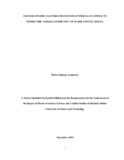| dc.description.abstract | Conflict is a global phenomenon which is being experienced every time and again. The conflict
between Degodia and Ajuran clans of Wajir County started long before the arrival of
colonialists. They conflict mostly because of control of resources. In a nut shell, it has got a
devastating effect on social, political and economic aspects of life. The study aimed at
establishing the socio-economic factors influencing the existing inter-clan conflicts among the
Somali communities in Wajir North Sub-County, Wajir County. Specific objectives were to:
assess the extent and nature of inter-clan conflicts among the Somali communities in Wajir North
Sub-County; examine the socio-economic environment influencing inter-clan conflicts among
the Somali communities in Wajir North Sub-County, Kenya and Examine obstacles towards
managing inter-clan conflicts within the Somali community in Wajir North Sub-County Kenya.
The study was based on two theories which are Social Conflict Theory by Karl Max (1818-1883)
and Human Needs Theory by John Burton (1932 to date). Descriptive and historical research
designs were used. The study sampled 492 respondents who included 400 household heads, 25
assistant chiefs, 16 police officers, 20 business entities, 4 NGOs, 15 Village Elders and 12 youth
leaders in peace committees. Questionnaires, Focus Group Discussion, observation checklists
and interviews were used in data collection. The study employed both probabilistic and nonprobabilistic
sampling methods to attain the targeted sample size. Quantitative was collected
using questionnaires. On the other hand, interviews, FGD and observation were used in gathering
qualitative data. Quantitative data was analyzed using SPSS and MS Excel version 20 in order to
obtain descriptive statistics to aid in easy analysis. Thematic techniques were employed in
analyzing qualitative data. Quantitative data was presented using tables, graphs, and charts while
verbatim narratives were used in presenting qualitative data. The secondary data method was
applied in that review of various documents whether published or non-published was done.
These included journal articles, books, previous master oral thesis, doctoral thesis and data from
government offices with a view of obtaining related literature on the subject under study. The
study findings are of significant use in policy and academic decision making. The study findings
have both policy and academic implications to the communities, local leaders and the National
and County governments in addressing inter-clan conflicts between communities living in Wajir
North Sub-County. The findings of the study indicate that the key perpetrators of inter-clan
conflicts were youths (97%) and livestock rustlers (97%). The study also revealed that guns were
the most used weapons (43%) followed by panga/machetes (31%). The study further found out
that unemployment (51%) were the main cause of conflict followed by scarcity of resources
(38%). Bad cultural practices (34%) also made the communities to keep fighting. The conflicts
caused deaths (64%) destruction and loss of property (100%), displacements (98%). Youth
employment (72%) and solving historical injustices (68%) would increase harmony among the
communities and would help in propagating peace between them. The recurrence of the interclan
conflicts in Kenya are associated to competition of the scarce resources land, cultural
rivalry, cultural identities as well as political activities. The study concludes that socio-economic
factors influence the recurrence of inter-clan conflicts in Wajir North Sub-County Kenya.
Likewise failure to address serious economic concerned such as poverty unemployment, land
issues has made conflict management difficult. In the study area. The study recommends
continuous public campaigns and public awareness to fight inter-clan conflicts Also, there should
be fair distribution of resources in Wajir North Sub-county so that all the communities can
benefit equally. | en_US |

